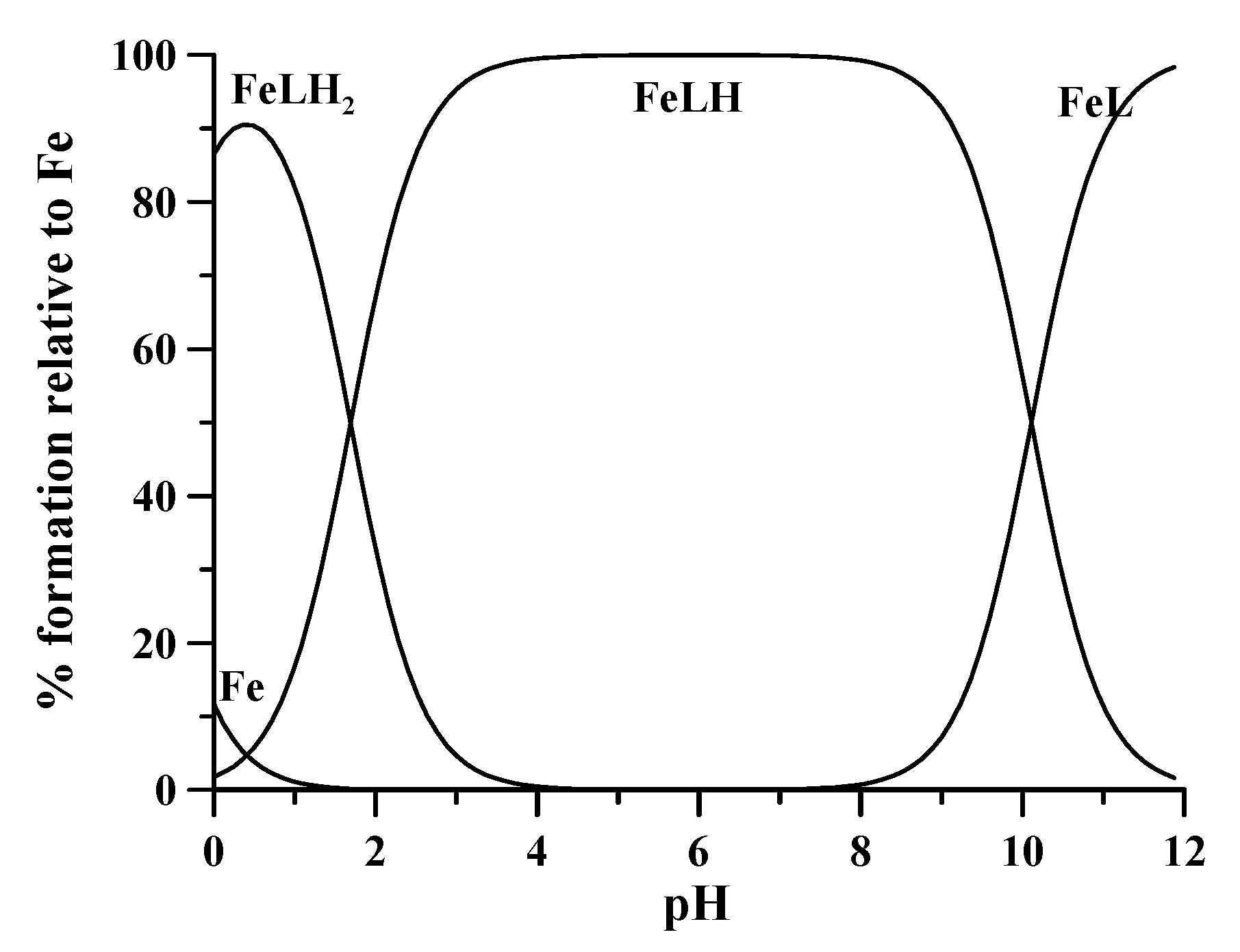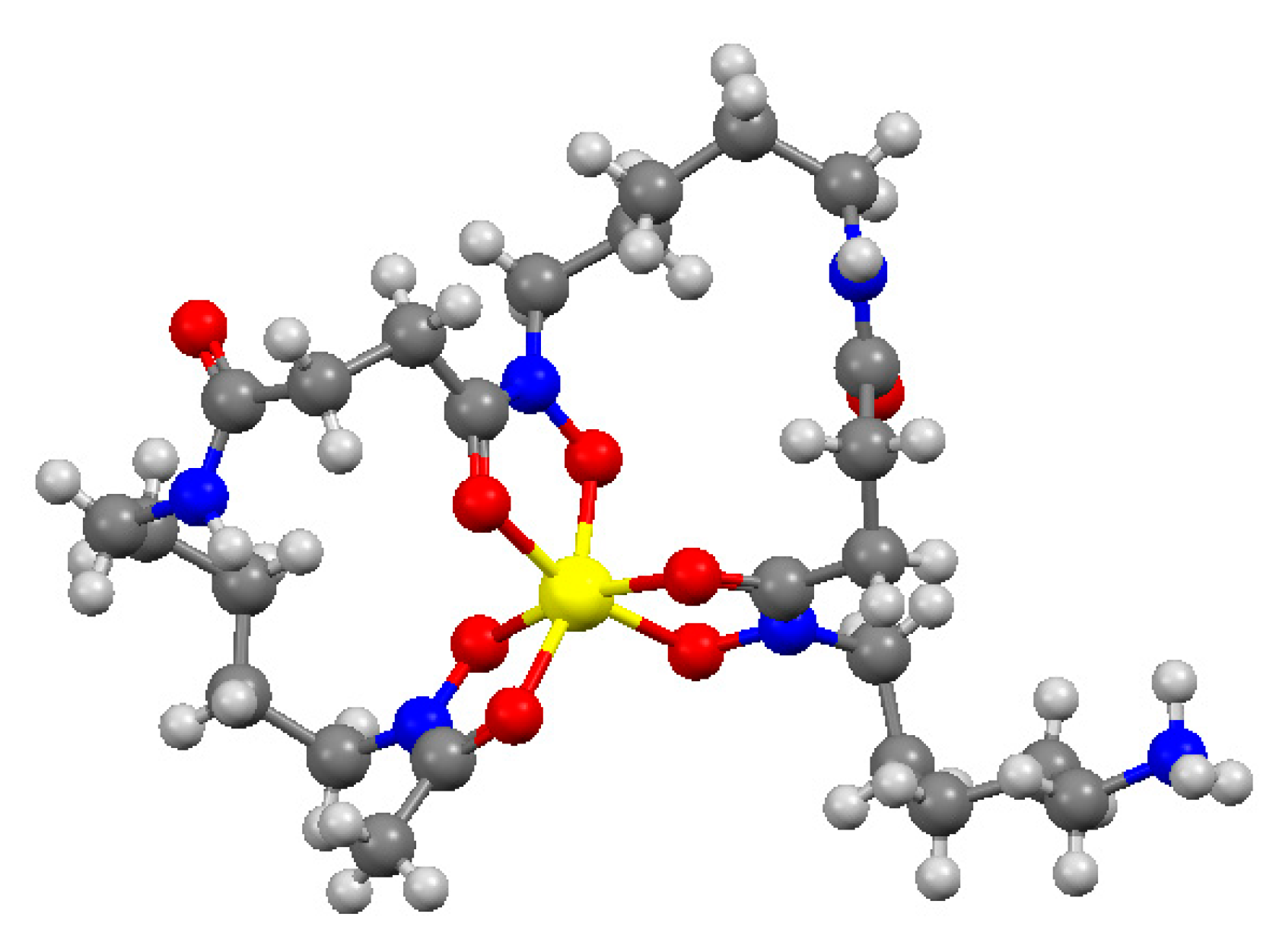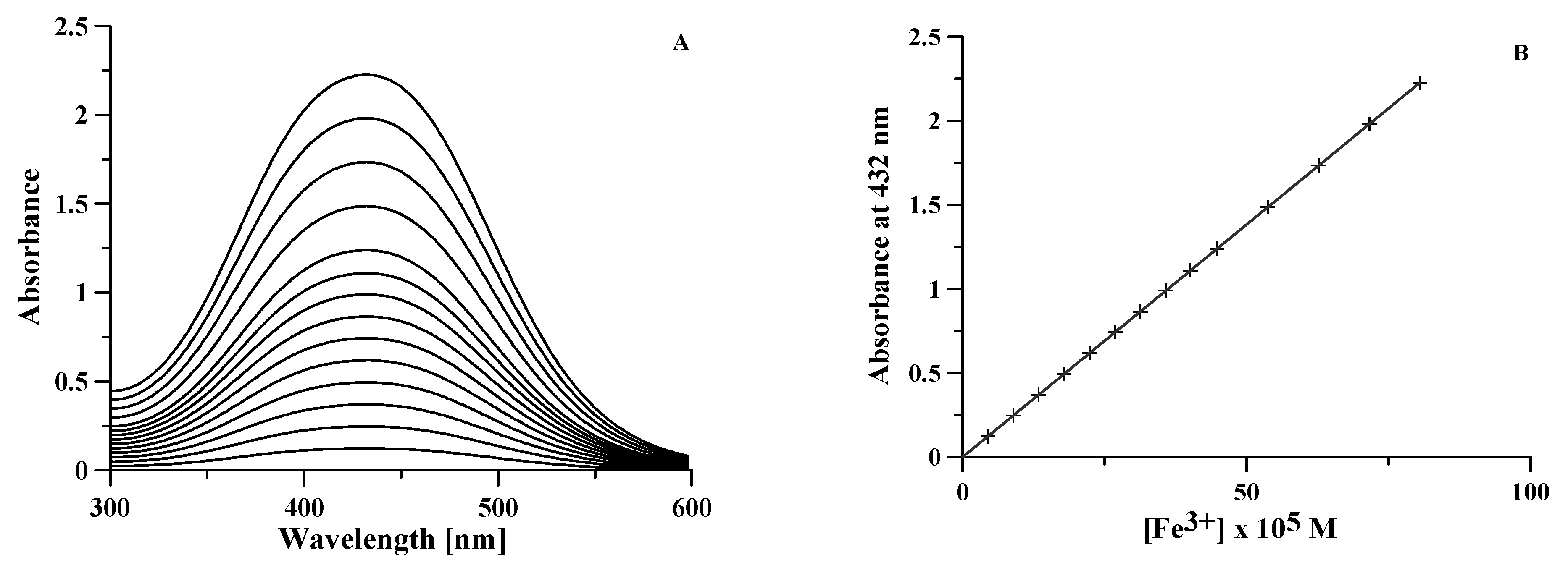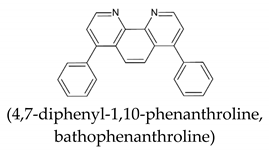A Friendly Complexing Agent for Spectrophotometric Determination of Total Iron
Abstract
1. Introduction
2. Results and Discussion
2.1. Spectrophotometric Analysis and Requisites of Colorimetric Reagents
- (1)
- Formation of a single complex of a definite stoichiometry, stable in a wide pH range;
- (2)
- High stability of the formed complex;
- (3)
- Fast reaction of complex formation;
- (4)
- Selectivity toward the target metal ion;
- (5)
- High values of absorptivity ε.
2.2. Main Features of the Fe3+-DFO Interactions
2.3. Calibration Plot
2.4. Available pH Range
2.5. Effects of Other Metal Ions
2.6. Determination of Total Iron
2.7. Validation: LoD and LoQ
2.8. Precision
2.9. Trueness and Application to Reference Materials
3. Materials and Methods
3.1. Chemicals
3.2. Instrumentation
4. Conclusions
Author Contributions
Funding
Institutional Review Board Statement
Informed Consent Statement
Data Availability Statement
Conflicts of Interest
Sample Availability
References
- Sammour, H.M.; Sheglila, A.T.; Aly, F.A. Stability of iron(III)-Thiocyanate complexes and the dependence of absorbance on the nature of the anion. Analyst 1977, 102, 180–186. [Google Scholar] [CrossRef]
- Marczenko, Z.; Balcerzak, M. Separation, Preconcentration and Spectrophotometry in Inorganic Analysis, 1st ed.; Elsevier Science: Amsterdam, The Netherland, 2000. [Google Scholar]
- Nurchi, V.M.; Crisponi, G.; Pivetta, T.; Donatoni, M.; Remelli, M. Potentiometric, spectrophotometric and calorimetric study on iron(III) and copper(II) complexes with 1,2-dimethyl-3-hydroxy-4-pyridinone. J. Inorg. Biochem. 2008, 102, 684–692. [Google Scholar] [CrossRef]
- Kolthoff, I.M.; Leussing, D.L.; Lee, T.S. Reaction of Ferrous and Ferric Iron with 1,10-Phenanthroline. III. The Ferrous Monophenanthroline Complex and the Colorimetric Determination of Phenanthroline. J. Am. Chem. Soc. 1950, 72, 2173–2177. [Google Scholar] [CrossRef]
- Smith, G.F.; McCurdy, W.H.; Diehl, H. The colorimetric determination of iron in raw and treated municipal water supplies by use of 4:7-diphenyl-1:10-phenanthroline. Analyst 1952, 77, 418–422. [Google Scholar] [CrossRef]
- Smith, G.F.; Cagle, F.W. The Improved Synthesis of 5-Nitro-1, 10-Phenanthroline. J. Org. Chem. 1947, 12, 781–784. [Google Scholar] [CrossRef] [PubMed]
- Crisponi, G.; Nurchi, V.M.; Lachowicz, J.I. Iron Chelation for Iron Overload in Thalassemia. In Metal Ions in Life Sciences; Sigel, A., Freisinger, E., Sigel, R.K.O., Eds.; Walter de Gruyter GmbH: Berlin, Germany, 2019; pp. 49–86. [Google Scholar]
- Nurchi, V.M.; Cappai, R.; Chand, K.; Chaves, S.; Gano, L.; Crisponi, G.; Peana, M.; Zoroddu, M.A.; Santos, M.A. New strong extrafunctionalizable tris(3,4-HP) and bis(3,4-HP) metal sequestering agents: Synthesis, solution and: In vivo metal chelation. Dalton Trans. 2019, 48, 16167–16183. [Google Scholar] [CrossRef]
- Biesuz, R.; Emma, G.; Milanese, C.; Dacarro, G.; Taglietti, A.; Nurchi, V.M.; Alberti, G. Novel DFO-SAM on mesoporous silica for iron sensing. Part I. Synthesis optimization and characterization of the material. Analyst 2014, 139, 3932–3939. [Google Scholar] [CrossRef]
- Alberti, G.; Emma, G.; Colleoni, R.; Pesavento, M.; Nurchi, V.M.; Biesuz, R. Novel DFO-functionalized mesoporous silica for iron sensing. Part 2. Experimental detection of free iron concentration (pFe) in urine samples. Analyst 2014, 139, 3940–3948. [Google Scholar] [CrossRef]
- Alberti, G.; Zanoni, C.; Magnaghi, L.R.; Am, M.; Nurchi, V.M. DFO@EVOH and 3,4-HP@EVOH: Towards New Polymeric Sorbents for Iron (III). Chemosensors 2020, 8, 111. [Google Scholar] [CrossRef]
- Alberti, G.; Quattrini, F.; Colleoni, R.; Nurchi, V.M.; Biesuz, R. Deferoxamine-paper for iron(III) and vanadium(V) sensing. Chem. Pap. 2015, 69, 1024–1032. [Google Scholar] [CrossRef]
- Budavari, S. The Merck Index, An Encyclopedia of Chemical Drugs and Biologicals; Merck: Rahway, NJ, USA, 1989. [Google Scholar]
- Alderighi, L.; Gans, P.; Ienco, A.; Peters, D.; Sabatini, A.; Vacca, A. Hyperquad simulation and speciation (HySS): A utility program for the investigation of equilibria involving soluble and partially soluble species. Coord. Chem. Rev. 1999, 184, 311–318. [Google Scholar] [CrossRef]
- Farkas, E.; Enyedy, É.A.; Csóka, H. A comparison between the chelating properties of some dihydroxamic acids, desferrioxamine B and acetohydroxamic acid. Polyhedron 1999, 18, 2391–2398. [Google Scholar] [CrossRef]
- Dhungana, S.; White, P.S.; Crumbliss, A.L. Crystal structure of ferrioxamine B: A comparative analysis and implications for molecular recognition. J. Biol. Inorg. Chem. 2001, 6, 810–818. [Google Scholar] [CrossRef] [PubMed]
- Spasojević, I.; Armstrong, S.K.; Brickman, T.J.; Crumbliss, A.L. Electrochemical behavior of the Fe(III) complexes of the cyclic hydroxamate siderophores alcaligin and desferrioxamine E. Inorg. Chem. 1999, 38, 449–454. [Google Scholar] [CrossRef] [PubMed]
- Monzyk, B.; Crumbliss, A.L. Kinetics and Mechanism of the Stepwise Dissociation of Iron(III) from Ferrioxamine B in Aqueous Acid. J. Am. Chem. Soc. 1982, 104, 4921–4929. [Google Scholar] [CrossRef]
- Birus, M.; Bradic, Z.; Krznaric, G.; Kujundzic, N.; Pribanic, M.; Wilkins, P.C.; Wilkins, R.G. Kinetics of Stepwise Hydrolisis of Ferrioxamine B and of Formation of Diferrioxamine B in Acid Perchlorate Solution. Inorg. Chem. 1987, 26, 1000–1005. [Google Scholar] [CrossRef]
- Endrizzi, F.; Di Bernardo, P.; Zanonato, P.L.; Tisato, F.; Porchia, M.; Isse, A.A.; Melchior, A.; Tolazzi, M. Cu(i) and Ag(i) complex formation with the hydrophilic phosphine 1,3,5-triaza-7-phosphadamantane in different ionic media. How to estimate the effect of a complexing medium. Dalton Trans. 2017, 46, 1455–1466. [Google Scholar] [CrossRef]
- Harris, W.R.; Raymond, K.N.; Weitl, F.L. Ferric Ion Sequestering Agents. The Spectrophotometric and Potentiometric Evaluation of Sulfonated Tricatecholate Ligands. J. Am. Soc. 1981, 103, 2667–2675. [Google Scholar] [CrossRef]
- Farkas, E.; Enyedy, É.A.; Csóka, H. Some factors affecting metal ion-monohydroxamate interactions in aqueous solution. J. Inorg. Biochem. 2000, 79, 205–211. [Google Scholar] [CrossRef]
- Enyedy, É.A.; Pócsi, I.; Farkas, E. Complexation of desferricoprogen with trivalent Fe, Al, Ga, In and divalent Fe, Ni, Cu, Zn metal ions: Effects of the linking chain structure on the metal binding ability of hydroxamate based siderophores. J. Inorg. Biochem. 2004, 98, 1957–1966. [Google Scholar] [CrossRef]
- Farkas, E.; Csóka, H.; Micera, G.; Dessi, A. Copper(II), nickel(II), zinc(II), and molybdenum(VI) complexes of desferrioxamine B in aqueous solution. J. Inorg. Biochem. 1997, 65, 281–286. [Google Scholar] [CrossRef]
- Van Reyk, D.; Dean, R. The Iron-Selective Chelator Desferal Can Reduce Chelated Copper. Free Radic. Res. 1996, 24, 55–60. [Google Scholar] [CrossRef] [PubMed]
- Goodwin, J.F.; Whitten, C.F. Chelation of ferrous sulphate solutions by desferrioxamine B. Nature 1965, 205, 281–283. [Google Scholar] [CrossRef] [PubMed]
- Yegorov, D.Y.; Kozlov, A.V.; Azizova, O.A.; Vladimirov, Y.A. Simultaneous determination of Fe(III) and Fe(II) in water solutions and tissue homogenates using desferal and 1,10-phenanthroline. Free Radic. Biol. Med. 1993, 15, 565–574. [Google Scholar] [CrossRef]
- Currie, L.A. Nomenclature in evaluation of analytical methods including detection and quantification capabilities (IUPAC Recommendations 1995). Anal. Chim. Acta 1999, 391, 105–126. [Google Scholar] [CrossRef]
- Horwitz, W. Evaluation of Analytical Methods Used for Regulation of Foods and Drugs. Anal. Chem. 1982, 54, 67A–76A. [Google Scholar] [CrossRef]
- International Programme on Chemical Safety. Guidelines for Drinking-Water Quality, 2nd ed.; WHO: Geneva, Switzerland, 2010; Available online: https://www.who.int/water_sanitation_health/dwq/chemicals/iron.pdf (accessed on 13 April 2021).
- Albert, A.; Serjeant, E.P. Ionization Constants of Acids and Bases: A Laboratory Manual; Methuen: London, UK, 1962. [Google Scholar]






| Spectral Info | Ref. | |
|---|---|---|
 | ε = 11,000 M−1cm−1 λmax = 512 nm | [4] |
 | ε = 22,400 M−1cm−1 λmax = 533 nm | [5] |
 | ε = 8700 M−1cm−1 λmax = 522 nm | [6] |
| Spectral Info | Ref. | |
|---|---|---|
| SCN− thiocyanate | ε = 8530 M−1cm−1 λmax = 480 nm | [1] |
 | ε = 4400 M−1cm−1 λmax = 440 nm | [3] |
| Metal Ion | [MLH3] | [MLH2] | [MLH] | [ML] | [M2LH] | pM | Ref. |
|---|---|---|---|---|---|---|---|
| Fe3+ | 42.4 | 41.01 | 30.4 | 26.5 | [15] | ||
| Al3+ | 36.6 | 33.8 | 23.9 | 19.3 | [22] | ||
| Ga3+ | 36.92 | 27.56 | 22.4 | [23] | |||
| In3+ | 36.40 | 32.48 | 22.18 | 18.0 | [17] | ||
| Cu2+ | 36.99 | 33.10 | 23.98 | 13.73 | 32.09 | 11.2 | [24] |
| Ni2+ | 33.20 | 27.66 | 19.71 | 8.89 | 6.3 | [18] | |
| Zn2+ | 33.40 | 28.17 | 20.40 | 10.36 | 6.6 | [18] |
| Presence of Al3+ | Presence of Ga3+ | |||
|---|---|---|---|---|
| Molar Concentration of Interfering Metal Ion | Molar Concentration × 104 | |||
| [FeLH]+ pH 6 | [FeLH]+ pH 7 | [FeLH]+ pH 6 | [FeLH]+ pH 7 | |
| 0 | 4.9998 | 4.9988 | 4.9998 | 4.9988 |
| 5 × 10−4 | 4.9998 | 4.9988 | 4.9998 | 4.9988 |
| 5 × 10−3 | 4.9998 | 4.9988 | 4.9983 | 4.9973 |
| 5 × 10−2 | 4.9997 | 4.9987 | 4.9818 | 4.9807 |
| Certified Iron Concentration (μg/L) | Measured Iron Concentration (μg/L) | Recovery (%) | |
|---|---|---|---|
| NIST SRM 1643f Natural Water | 93.4(0.8) | 95(1) | 102 |
| ClinChek® Control Human Urine Level II | 222 | 215(2) | 97 |
| ClinChek® Control Blood Serum Level I | 905 | 935(7) | 103 |
Publisher’s Note: MDPI stays neutral with regard to jurisdictional claims in published maps and institutional affiliations. |
© 2021 by the authors. Licensee MDPI, Basel, Switzerland. This article is an open access article distributed under the terms and conditions of the Creative Commons Attribution (CC BY) license (https://creativecommons.org/licenses/by/4.0/).
Share and Cite
Nurchi, V.M.; Cappai, R.; Spano, N.; Sanna, G. A Friendly Complexing Agent for Spectrophotometric Determination of Total Iron. Molecules 2021, 26, 3071. https://doi.org/10.3390/molecules26113071
Nurchi VM, Cappai R, Spano N, Sanna G. A Friendly Complexing Agent for Spectrophotometric Determination of Total Iron. Molecules. 2021; 26(11):3071. https://doi.org/10.3390/molecules26113071
Chicago/Turabian StyleNurchi, Valeria M., Rosita Cappai, Nadia Spano, and Gavino Sanna. 2021. "A Friendly Complexing Agent for Spectrophotometric Determination of Total Iron" Molecules 26, no. 11: 3071. https://doi.org/10.3390/molecules26113071
APA StyleNurchi, V. M., Cappai, R., Spano, N., & Sanna, G. (2021). A Friendly Complexing Agent for Spectrophotometric Determination of Total Iron. Molecules, 26(11), 3071. https://doi.org/10.3390/molecules26113071









